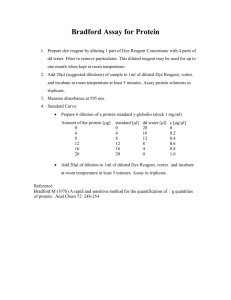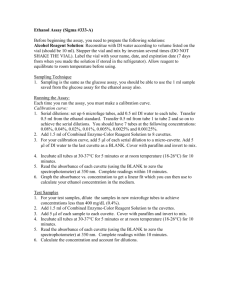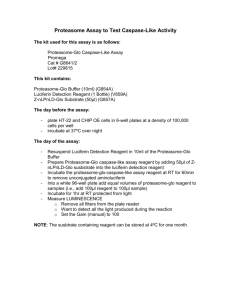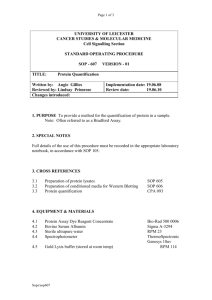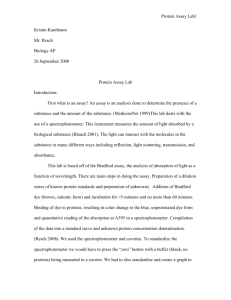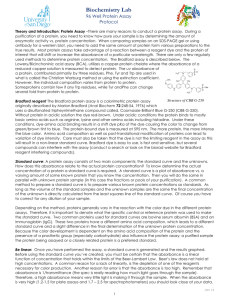Quantitation of Protein
advertisement
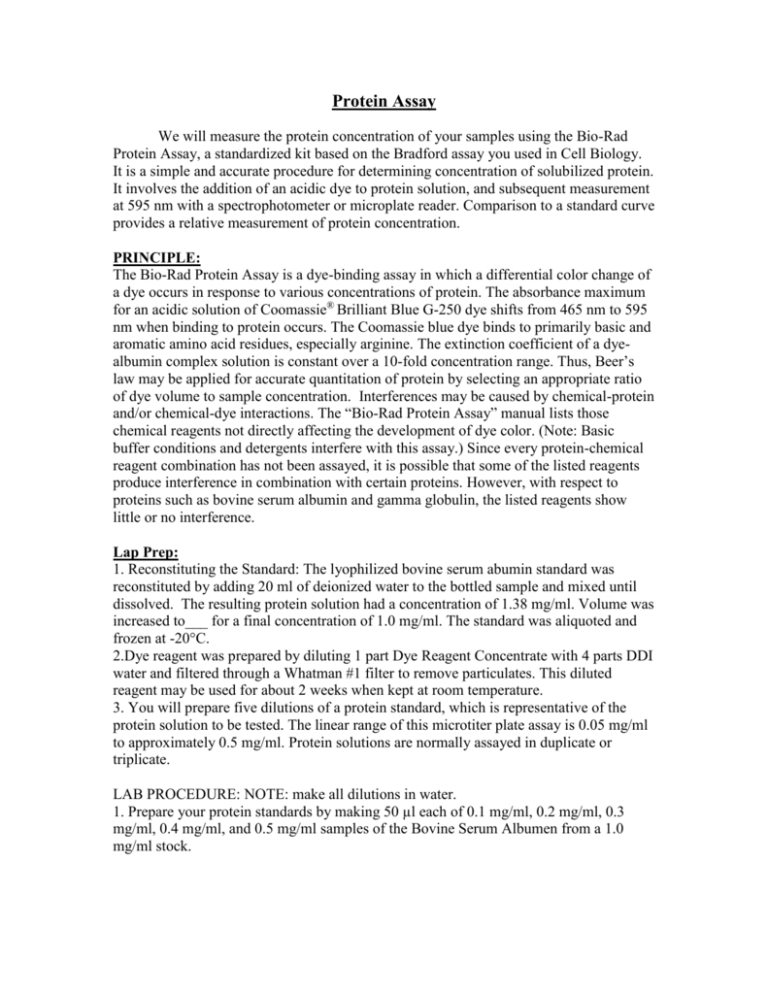
Protein Assay We will measure the protein concentration of your samples using the Bio-Rad Protein Assay, a standardized kit based on the Bradford assay you used in Cell Biology. It is a simple and accurate procedure for determining concentration of solubilized protein. It involves the addition of an acidic dye to protein solution, and subsequent measurement at 595 nm with a spectrophotometer or microplate reader. Comparison to a standard curve provides a relative measurement of protein concentration. PRINCIPLE: The Bio-Rad Protein Assay is a dye-binding assay in which a differential color change of a dye occurs in response to various concentrations of protein. The absorbance maximum for an acidic solution of Coomassie® Brilliant Blue G-250 dye shifts from 465 nm to 595 nm when binding to protein occurs. The Coomassie blue dye binds to primarily basic and aromatic amino acid residues, especially arginine. The extinction coefficient of a dyealbumin complex solution is constant over a 10-fold concentration range. Thus, Beer’s law may be applied for accurate quantitation of protein by selecting an appropriate ratio of dye volume to sample concentration. Interferences may be caused by chemical-protein and/or chemical-dye interactions. The “Bio-Rad Protein Assay” manual lists those chemical reagents not directly affecting the development of dye color. (Note: Basic buffer conditions and detergents interfere with this assay.) Since every protein-chemical reagent combination has not been assayed, it is possible that some of the listed reagents produce interference in combination with certain proteins. However, with respect to proteins such as bovine serum albumin and gamma globulin, the listed reagents show little or no interference. Lap Prep: 1. Reconstituting the Standard: The lyophilized bovine serum abumin standard was reconstituted by adding 20 ml of deionized water to the bottled sample and mixed until dissolved. The resulting protein solution had a concentration of 1.38 mg/ml. Volume was increased to___ for a final concentration of 1.0 mg/ml. The standard was aliquoted and frozen at -20°C. 2.Dye reagent was prepared by diluting 1 part Dye Reagent Concentrate with 4 parts DDI water and filtered through a Whatman #1 filter to remove particulates. This diluted reagent may be used for about 2 weeks when kept at room temperature. 3. You will prepare five dilutions of a protein standard, which is representative of the protein solution to be tested. The linear range of this microtiter plate assay is 0.05 mg/ml to approximately 0.5 mg/ml. Protein solutions are normally assayed in duplicate or triplicate. LAB PROCEDURE: NOTE: make all dilutions in water. 1. Prepare your protein standards by making 50 µl each of 0.1 mg/ml, 0.2 mg/ml, 0.3 mg/ml, 0.4 mg/ml, and 0.5 mg/ml samples of the Bovine Serum Albumen from a 1.0 mg/ml stock. 2. Make your samples by making 100 µl serial dilutions of 1:10 and 1:100. Thus, you will have three samples: undiluted, 10 fold dilution, and 100 fold dilution. You will use 10 µl samples in this assay. Do two assays for each sample (total 6 assays/group + 5 standards). 3. Pipet 10 µl of each standard and sample solution into separate microtiter plate wells. 4. Add 200 µl of diluted dye reagent to each well. Mix the sample and reagent thoroughly by shallow pipetting. Depress the plunger repeatedly to mix the sample and reagent in the well. Replace with clean tips and add reagent to the next set of wells. 5. Incubate at room temperature for at least 5 minutes. Absorbance will increase over time; samples should incubate at room temperature for no more than 1 hour. 6. Measure absorbance at 595 nm.
